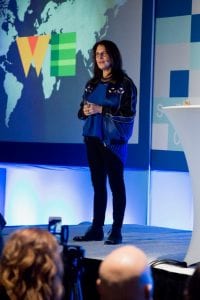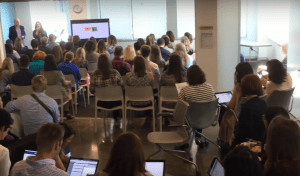 Sally Ride had just become the first American woman in space. Motorola introduced the first mobile phones to the United States. Microsoft launched Word, its first word processing program. And the personal computer was named TIME’s “Person of the Year.”
Sally Ride had just become the first American woman in space. Motorola introduced the first mobile phones to the United States. Microsoft launched Word, its first word processing program. And the personal computer was named TIME’s “Person of the Year.”
The year was 1983 when the first female-owned PR agency in America opened its doors in Seattle. Its ground floor client was the small company with the new Word toolbox, a business named Microsoft, in a fledgling industry called software.
The founders of this historic PR firm, Melissa Waggener and (in memoriam) Pam Edstrom, were committed to stay focused on two BIG things: Technology and People.
While few people at the time understood or could anticipate the changes that technology had in store, these two did. Pam Edstrom had been an employee of Microsoft. Melissa Waggener’s appreciation was homemade. Her father was an engineer who always explained technology in terms of its purpose, not the technical underpinnings, per say, but the impact technology could have for people.
That notion, of purpose, became instilled in the young Waggener’s credo. “In many ways,” she related at the 2017 Seattle Interactive Conference, ”I’ve dedicated my life to this proposition: that the purpose of technology is to open up possibilities for people.”
Waggener Edstrom rebranded as WE Communications in 2015 and today employs 800 people around the world in 18 offices. They are still female-owned and independent. And they work with some of the world’s biggest brands, greatest thinkers and most generous philanthropists.
Purpose is still the slingshot that propels everything they do. In fact, WE has identified this practice of purpose with a hashtag: #forWhichWEStand. In her SIC keynote address, Melissa addressed the principles for which WE stands, and in no uncertain terms. WE is committed to bridging the gap in today’s society that revolves around the concept of Story.
“I think what we’re dealing with today is what you might call a profound Story Gap,” Waggener Zorkin explains.
A Story Gap is the delta between the truth—formerly known as facts—and what others claim it to be. A Story Gap is the distance between understanding and misunderstanding.
For instance, Waggener Zorkin expounds,“How dare we say climate change isn’t happening when the Antarctica ice shelf is melting not just on top, but inside? That’s a Story Gap.”
“How dare we say that it’s okay to reduce aid?” In addition to running WE Communications full time – Melissa is a board member of the International NGO named Mercy Corps.
“Many times I’ve been in Africa and the Middle East and I’ve seen this need,” she relates, “yet some people still don’t believe there’s even a problem. That’s a Story Gap!”
 To be clear, Waggener Zorkin also understands that no person or business can stand for everything. Yet, as she puts it, “You should also not stand for nothing. Be smart about what you choose to stand for, what your brand can reliably speak for, what your employees can fervently believe in. Then, be fearless in in standing in that Story Gap with a position on your issue.”
To be clear, Waggener Zorkin also understands that no person or business can stand for everything. Yet, as she puts it, “You should also not stand for nothing. Be smart about what you choose to stand for, what your brand can reliably speak for, what your employees can fervently believe in. Then, be fearless in in standing in that Story Gap with a position on your issue.”
Melissa cites Unilever as a prime example of how doing good also means doing well, what Waggener Zorkin has labelled the ‘Unilever Effect.’
Unilever’s CEO, Paul Polman, has led progressive action from devising water-saving to carbon-reducing formulations of its products. So it’s no big surprise that he serves as the only businessperson on the U.N. committee for Sustainable Development Goals.
“Unilever’s customers buy its products in part because of the company’s commitment to environmentally sustainable products, gender equality, and global anti-poverty initiatives. They buy its products because the company shares their values,” says Melissa.
Microsoft’s president Brad Smith is another proponent of “Where We Stand.” Smith declared that any federal government attempt to deport its “Dreamer” employees would “have to go through us to get that person.” He is following through by covering legal expenses for all affected employees.
And Seattle’s MOD Pizza chain with more than 200 locations in the US and UK believes in second chances. They’ve built an amazing team by deliberately hiring persons who were formerly incarcerated. The company is living its purpose every hire, every day.
 Jumping the Story Gap
Jumping the Story Gap
“PR can move mountains, “ as Cory Curtis of Intellectual Ventures, says.
“Well,” Waggener Zorkin adds, “If PR can move mountains, then together we can mend rifts and chasms caused by garbaged-up fake news. Everyone of us has the power to close a Story Gap.”
“Together,“ she says — “Teams, Co-workers, Partners, Customers — we become this invisible group, the StoryForce: where we use the power of story—and a really awesome plot twist—to jump the Story Gap.”
The storylines — and the plot twists and turns — that are evolving within the field of public relations are dramatic. We asked Melissa Waggener Zorkin to size-up how WE Communications is writing the next chapter in its storied history.
Seattle24x7: Semantically speaking, is “Public Relations” still the right term to define or describe what WE Communications provides? As the PR function has focused on more specific practices like community relations, investor relations, media relations, and so forth, are those functions best coordinated under one roof, or has a more multi-disciplinary approach spawned smaller specialty companies or divisions?
Melissa: Public Relations is alive and well, but the lines between it and adjacent disciplines are blurring. WE Communications helps companies and organizations shift perspectives and transform behaviors by telling the right story to the right person on the right channel and at the right time. To do that, we need to maintain our leadership in traditional media relations while simultaneously excelling at content marketing and strategy, social media, creative and other communication disciplines.
We can’t be all things to all people, so to augment our own capabilities we founded the PLUS Network, which brings together six independent specialist agencies to offer complementary marketing and communications services that span the entire media ecosystem of paid, owned, earned, social, experiential and search. This allows us the flexibility we love about being independent and the resources of the large holding companies.
Seattle24x7: From what we’ve read, the steps you have taken as an agency are rooted in solid research.
Melissa: Earlier this year, WE released our signature research study, Brands in Motion. Our belief is that brand positioning as we knew it is dead. Instead, all brands need to be in constant motion. In today’s marketplace there is no fixed point that a brand can aim for– the forces of geography, industry, stakeholder expectations, business environment and culture shift too quickly, and brands needs to move in concert with these forces in order to stay relevant and create innovation.
This is especially true for us and for the communication industry as well – we are constantly evolving, shifting, learning and growing.
We see this as great opportunity. These rapid shifts in the media ecosystem mean our clients need to be able to tell stories across channels and engage in new and unexpected ways, and we’re uniquely positioned to do that.
Seattle24x7: Does WE consider social media to be an organic extension of a company’s public relations? How can a company stay true to its authenticity when there are so many voices within an organization?
 Melissa: Absolutely, social media is part of a company’s public relations program. Any opportunity for a brand to engage with stakeholders impacts how they are perceived. Companies will vary on where the ownership of social media is housed organizationally, but, we strongly believe it is best served when it is in tight alignment with the overall marketing and communications of a brand.
Melissa: Absolutely, social media is part of a company’s public relations program. Any opportunity for a brand to engage with stakeholders impacts how they are perceived. Companies will vary on where the ownership of social media is housed organizationally, but, we strongly believe it is best served when it is in tight alignment with the overall marketing and communications of a brand.
When a company has clearly articulated its brand, its values and its mission, and is operating with those at its center, employees and customers become the best and most authentic brand storytellers.
We encourage companies to have clear, centralized guidelines that ensure everyone is operating within the law and ethical standards but we counsel our clients that it’s most important to clearly articulate their brand narrative. Organizations need to bring stakeholders in to their vision and back it up with action so that they become true advocates.
Seattle24x7: How do you work with clients to understand the constituencies or audiences with whom they are in dialogue?
Melissa: We use any and all of the tools at our disposal to better understand audiences, knowing who needs to hear the message. Really caring about them is at the core of powerful communications. In addition to our Brands in Motion research, we rolled out a complimentary report called Stories in Motion that looked at how, when and where people engage with media and branded content. This kind of information helps us counsel our clients on how they can breakthrough with very specific audiences at the right moment in time.
Seattle24x7: It is an understatement to say that the Internet has transformed the way companies interact with their customers. In this new age, every company seems compelled to take on an expanded role in their communications and outreach.
Melissa: The digital age means every brand can tell its own story. Owned content and social media are key components of the modern PR mix.
The best communications strategies work 360-degrees across the media landscape, including paid, earned and owned. We have clients that we support across this spectrum, but we counsel clients that they need to have these functions aligned in order to maximize their investment in communications and reach their audiences.
Seattle24x7: Search engine “link building” has been called the new Internet PR since it involves community outreach and engaging authoritative entities (resources, publications, and associations) to link back to a given Website. Should PR firms be involved in the link building process?
Melissa: Absolutely. Link-building is arguably the most important pillar of SEO, and PR agencies are natural link-builders by virtue of our networks of media professionals and opinion leaders.
The goal of SEO is often thought leadership, which has long been in the domain of PR. And while the methods for building thought leadership have changed, the core skills that are required have not. This is why clients increasingly turn to PR for support in creating authoritative content and sharing it with the influencers who matter.
Seattle24x7: Let’s imagine the United State of America was a WE client. “We, the People” walks in the door. How would you set out to bridge the incredible divide in the country’s political and socio-economic polarization?
Melissa: This is a big, daunting question but it’s one that I have been thinking a lot about. And I keep coming back to one of the guiding principles of my life: Be the change you wish to see in the world.
It’s easy to point fingers and blame. It is easy to fire off messages on Twitter. It’s easy to throw up your hands and say nothing will ever get better. And it’s easy to plug your ears and not learn about a new idea. What’s hard is rolling up your sleeves and doing something.
So I’d give our “We the People” the same advice I gave to the Seattle Interactive community: 1) Stand Up to Stand Out, 2) Do More Talk Less and 3) Bring Your Power. That means identifying what is important to us as a nation, moving from talking about what should be done to taking action, and doing everything to the best of our ability. [24×7]





















